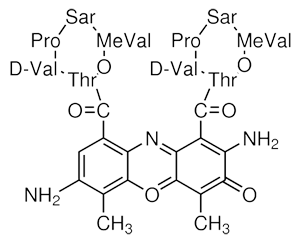All AbMole products are for research use only, cannot be used for human consumption.

7-aminoactinomycin D (7-aad) can bind to DNA, and the maximum excitation/emission wavelength is 546nm/647 nm. The best excitation laser is 561nm or 488nm. It gives red fluorescence and is often used to observe the nucleus and nucleic acid. Store in freezer (-5 to -30°C) away from light. The solvent was DMSO.
*The compound is unstable in solutions, freshly prepared is recommended

Ecotoxicol Environ Saf. 2022 Jun 1;237:113564.
Environmental BPDE induced human trophoblast cell apoptosis by up-regulating lnc-HZ01/p53 positive feedback loop
7-Aminoactinomycin D purchased from AbMole
| Cell Experiment | |
|---|---|
| Cell lines | Normal human embryonic lung fibroblasts |
| Preparation method | The corresponding data were obtained for binding of 7-AAMD using dye concentrations from 0.5 to 20 pM. The dye uptake for the dye concentration 0.5 pM was completed after 3 h. Staining with 7-AAMD resulted in higher background fluorescence, especially for unextracted samples, where it started at 15% of the nuclear fluorescence for the lowest dye concentration and amounting to about 40% for the highest. |
| Concentrations | 0.5 to 20 μM |
| Incubation time | 3 h |
| Animal Experiment | |
|---|---|
| Animal models | |
| Formulation | |
| Dosages | |
| Administration | |
| Molecular Weight | 1270.43 |
| Formula | C62H87N13O16 |
| CAS Number | 7240-37-1 |
| Solubility (25°C) | DMSO 10 mM |
| Storage | -20°C, protect from light |
| Related Nucleic Acid Staining Products |
|---|
| Cy5 maleimide
Cy5 maleimide is a CY dye. |
| Biotin-aniline
Biotin-aniline is a probe with substantially high reactivity towards RNA and DNA. |
| Methyl Green
Methyl Green is a potent fluorescent dye. Methyl Green is a DNA stains of cells and electrophoretic gels. Methyl Green can be used as a stain for direct measuring of viability by both microscopy and flow cytometry, with peaks at 633 and 677 nm. |
| Cyanine 5 Tyramide
Cyanine 5 Tyramide (Tyramide-Cy5) is a red fluorescent dye, it is used as reporter fluorescent substrate for horseradish peroxidase (HRP)-catalyzed deposition that is signal amplification technique in immunoassay and in situ hybridization of nucleic acids. Ex=645; Em=670 |
| Cyanine 5 Tyramide methyl indole
Cyanine 5 Tyramide (Tyramide-Cy5) methyl indole is a red fluorescent dye. |
All AbMole products are for research use only, cannot be used for human consumption or veterinary use. We do not provide products or services to individuals. Please comply with the intended use and do not use AbMole products for any other purpose.


Products are for research use only. Not for human use. We do not sell to patients.
© Copyright 2010-2024 AbMole BioScience. All Rights Reserved.
